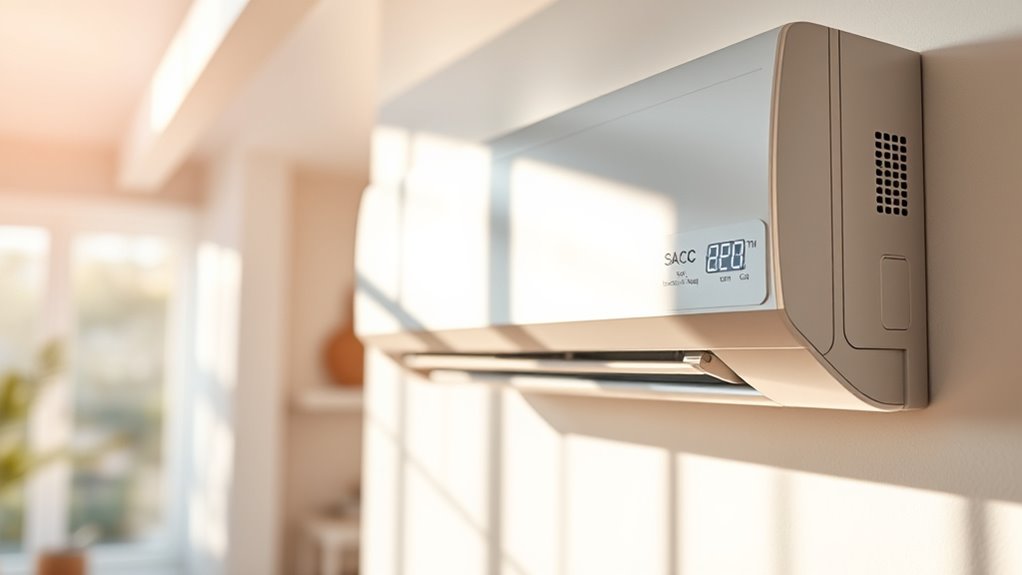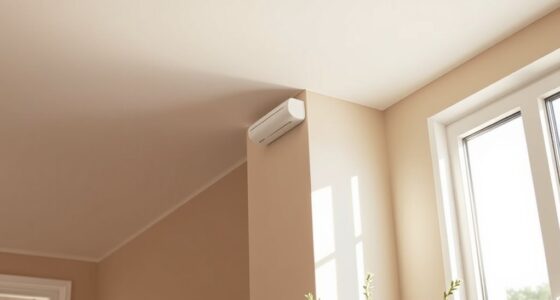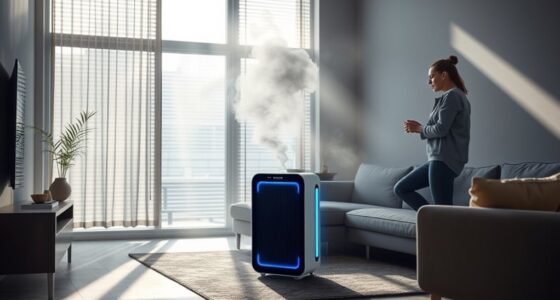When choosing an AC, understanding the difference between SACC and BTU helps you pick the right unit. BTU measures how much heat your AC can remove per hour, which is important for matching your space size. SACC, on the other hand, shows how efficiently your AC operates over a season, impacting your long-term savings. Knowing which rating matters most depends on your needs—if you want to save energy and money, SACC is key. Keep going to find out more.
Key Takeaways
- SACC measures seasonal energy efficiency and eco-friendliness, while BTU indicates cooling capacity per hour.
- SACC helps optimize overall energy savings and reduces operational costs over time.
- BTU is essential for matching AC size to room dimensions for effective cooling.
- Proper sizing with BTU prevents inefficiencies like short cycling and excessive noise.
- Both metrics are important; SACC for efficiency and environment, BTU for capacity and comfort.
What Is SACC and How Does It Work?

Have you ever wondered how SACC systems improve energy efficiency in cooling processes? SACC, or Seasonal Air Conditioning Coefficient, measures how effectively your AC converts electricity into cooling power over a season. A higher SACC means more energy savings because the system uses less power for the same cooling output. To maximize these benefits, proper installation is key; verify your unit is correctly sized and placed in a shaded, ventilated area. Good installation tips include sealing ductwork tightly and avoiding obstructions that hinder airflow. Additionally, understanding the beach environment can help you select the best location for outdoor units, ensuring optimal airflow and performance. SACC provides an exhaustive view of an AC’s seasonal performance, helping you choose a more efficient model. Understanding this metric helps you save energy and cut costs, making your cooling system more eco-friendly and wallet-friendly.
Understanding BTU: The Classic Cooling Measurement

BTU, or British Thermal Unit, is a standard measure of an air conditioner’s cooling capacity. It tells you how much heat the unit can remove from a room, making it easier to match with your space. Understanding BTU helps you choose the right size for effective cooling without wasting energy. Additionally, considering the cooling capacity ensures optimal performance and comfort.
BTU Defined Clearly
What exactly is a BTU, and why is it important when choosing cooling systems? BTU, or British Thermal Unit, measures the amount of heat an air conditioner can remove in an hour. Knowing this helps you select the right size for your space, avoiding energy waste or insufficient cooling. Many air conditioning myths suggest bigger units are always better, but that’s not true—overpowered units can cycle on and off, wasting energy. Instead, understanding BTU ensures you pick a system that matches your room’s size, saving you money and reducing energy consumption. Keep in mind, energy saving tips include choosing a properly rated unit with the right BTU to optimize efficiency and comfort. Proper sizing is key to avoiding common pitfalls and making smarter cooling choices.
Cooling Power Explained
Understanding the cooling power of an air conditioner hinges on grasping what BTU measures. BTU, or British Thermal Units, indicates how much heat the unit can remove per hour. A higher BTU means more cooling capacity, which can lead to better energy savings if the unit is appropriately matched to your room size. Properly sized ACs use less energy because they don’t overwork or underperform, reducing costs and waste. Additionally, the BTU rating affects noise levels—larger units with higher BTUs can sometimes be noisier, though modern designs mitigate this. Knowing this, you can choose an AC that balances cooling power with energy efficiency, ensuring you stay comfortable without unnecessary energy use or disruptive noise. Modern units with appropriate BTU ratings also incorporate noise reduction technology, making them quieter during operation.
Room Size Match
Have you ever wondered how to choose the right size air conditioner for your room? Matching the BTU rating to your space is essential for energy savings and effective cooling. If your AC is too small, it’ll struggle to cool the room, leading to higher energy bills and wear on the unit. Conversely, an oversized unit cools too quickly, cycling on and off and wasting energy. To get it right, measure your room’s square footage and select an AC with a BTU rating suited for that size. Installation tips include ensuring proper insulation and sealing leaks to maximize efficiency. Proper room size match not only improves comfort but also optimizes energy savings, helping your AC run smoothly and last longer. Additionally, understanding AC ratings can help you make more informed decisions when choosing the right unit.
Comparing SACC and BTU: Key Differences
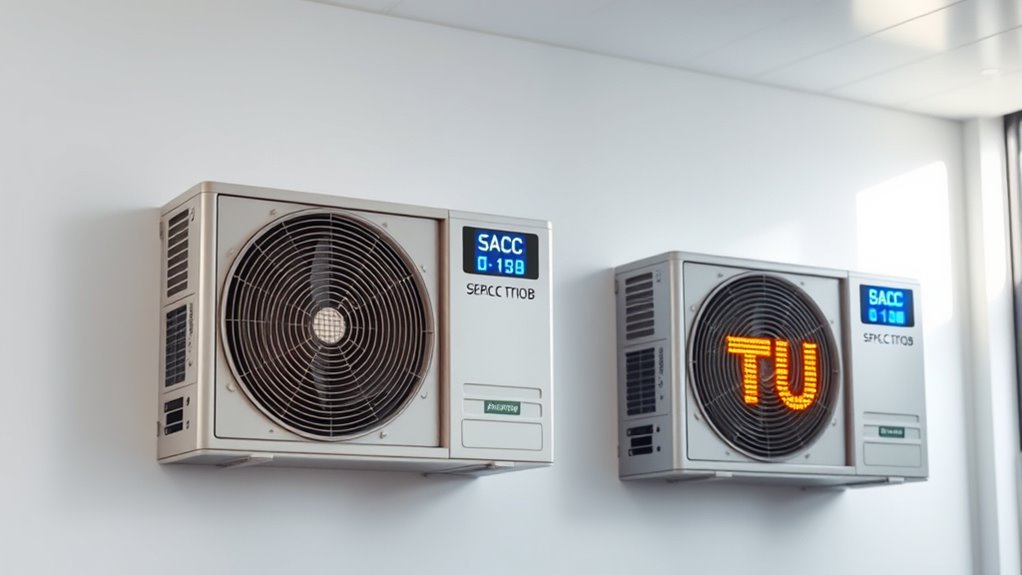
While both SACC and BTU are important in measuring energy, they serve different purposes and operate on different principles. BTU measures the total heat the air conditioner can remove per hour, which helps you understand cooling capacity. SACC, on the other hand, evaluates how efficiently your AC converts electrical energy into cooling power, directly impacting energy savings. A higher SACC rating indicates better efficiency, reducing your electricity bills. When comparing the two, consider installation considerations, like space constraints and electrical requirements, since a unit with a high BTU but low SACC might cool well but cost more to operate. Additionally, remote hackathons have become a popular way for teams to collaborate virtually on innovative solutions, which can include energy-efficient technology. Understanding these key differences helps you choose an AC that balances effective cooling with energy efficiency, leading to smarter investments and long-term savings.
Why SACC Matters More for Energy Efficiency
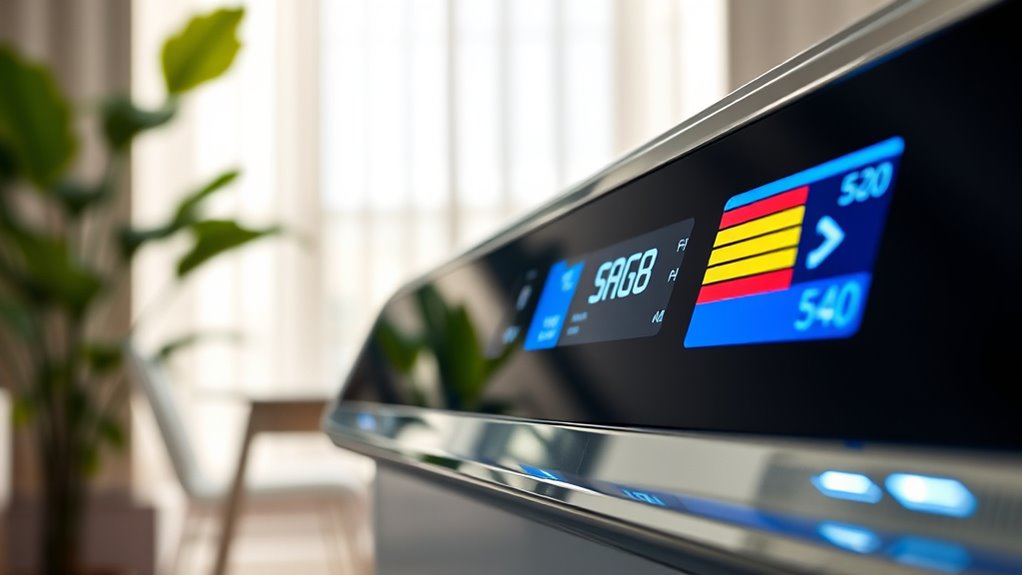
Understanding why SACC matters more for energy efficiency starts with recognizing how it provides accurate capacity measurements. This accuracy helps you select units that use less energy while delivering ideal cooling. As a result, better cooling efficiency means lower energy bills and a more sustainable choice for your space. Additionally, considering asset division strategies can help ensure you make informed decisions about your investments and resources during major household changes.
Accurate Capacity Measurement
Accurate capacity measurement is essential because it directly impacts the energy efficiency of cooling systems. When your AC’s capacity aligns with room size, it maintains ideal air quality and minimizes noise levels, ensuring comfort without wasting energy. Overestimating capacity leads to short cycling, increasing noise and reducing air quality, while underestimating causes inadequate cooling. SACC provides a precise measure of cooling capacity, unlike BTU ratings that can be misleading. Use the table below to understand how capacity accuracy affects performance:
| Effect of Accurate Capacity | Effect of Inaccurate Capacity |
|---|---|
| Better air quality | Poor air quality |
| Lower noise levels | Higher noise levels |
| Improved energy efficiency | Increased energy use |
| Longer system lifespan | Shortened lifespan |
| Consistent cooling comfort | Temperature fluctuations |
Additionally, understanding the SACC rating can help prevent unnecessary energy consumption and extend your AC’s lifespan.
Energy Consumption Impact
Using precise capacity measurements like SACC can substantially reduce your cooling system’s energy consumption. When your AC is accurately rated, it operates more efficiently, avoiding unnecessary energy use caused by over or under-sizing. This improved energy efficiency means your unit consumes less power to maintain the desired temperature, leading to significant cost savings over time. SACC ratings help you select an air conditioner that matches your space’s true cooling needs, preventing wasteful operation. As a result, you’ll notice lower electricity bills and a reduced environmental footprint. Additionally, understanding whole house fan energy consumption can provide alternative ways to enhance overall home energy efficiency. By prioritizing SACC over BTU, you ensure your system runs at its best, delivering better energy efficiency without sacrificing performance. Ultimately, this focus on accurate ratings benefits your wallet while supporting sustainable energy use.
Better Cooling Efficiency
Because SACC ratings measure the true cooling capacity of an air conditioner, they directly impact its efficiency. When you choose a unit with a higher SACC, you’ll experience better cooling performance without wasting energy. This means your AC operates more effectively, leading to significant energy saving over time. To maximize efficiency, guarantee proper installation with correct sizing and placement, as these factors influence how well your AC performs relative to its SACC. Installing the unit in a shaded, well-ventilated spot can further enhance cooling efficiency. By prioritizing SACC over BTU, you’ll reduce energy consumption and get better cooling results. Remember, an efficient AC saves you money on electricity bills and keeps your space more comfortable. Additionally, selecting a unit that complements your dog’s breed and size can optimize cooling and comfort in your space.
When Does BTU Still Play a Crucial Role?
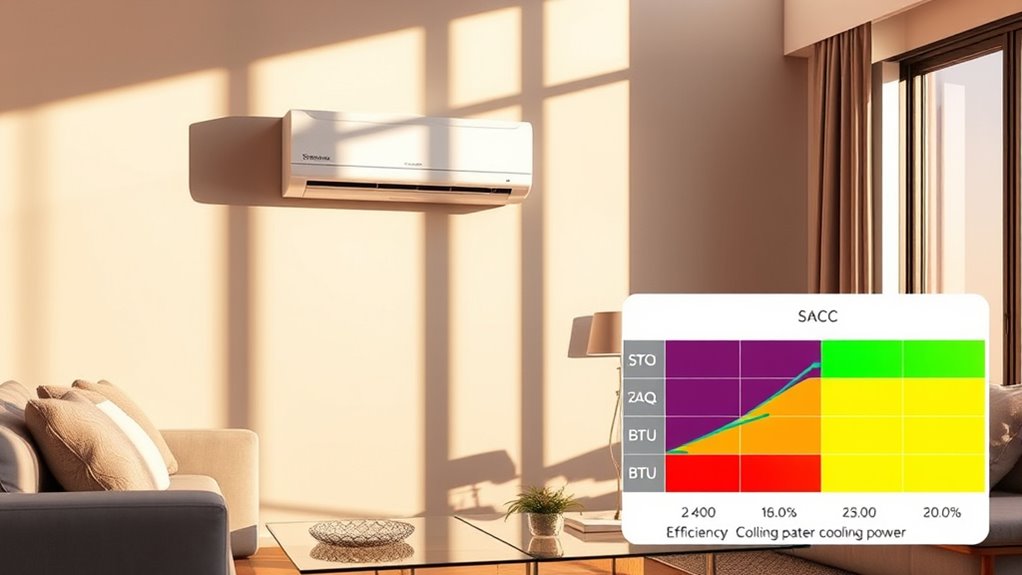
BTU still plays a crucial role when you’re evaluating the heating or cooling capacity needed for a space. If you have a larger room or an irregularly shaped area, choosing an AC with the right BTU guarantees effective temperature control without overworking the unit. This can lead to energy savings, as an appropriately sized AC runs efficiently and consumes less power. Additionally, the right BTU rating helps keep noise levels manageable; a unit that’s too powerful may cycle on and off frequently, increasing noise and wear. Conversely, an underpowered unit struggles to reach desired temperatures, causing frustration and higher energy costs. As a result, understanding BTU’s importance helps you select an AC that balances performance, energy efficiency, and noise, ensuring comfort and savings. Knowing how to build tension and use dynamic contrasts in trailer music can also teach you to better gauge how different BTU ratings impact the effectiveness of an air conditioner.
Choosing the Right Rating for Your Space
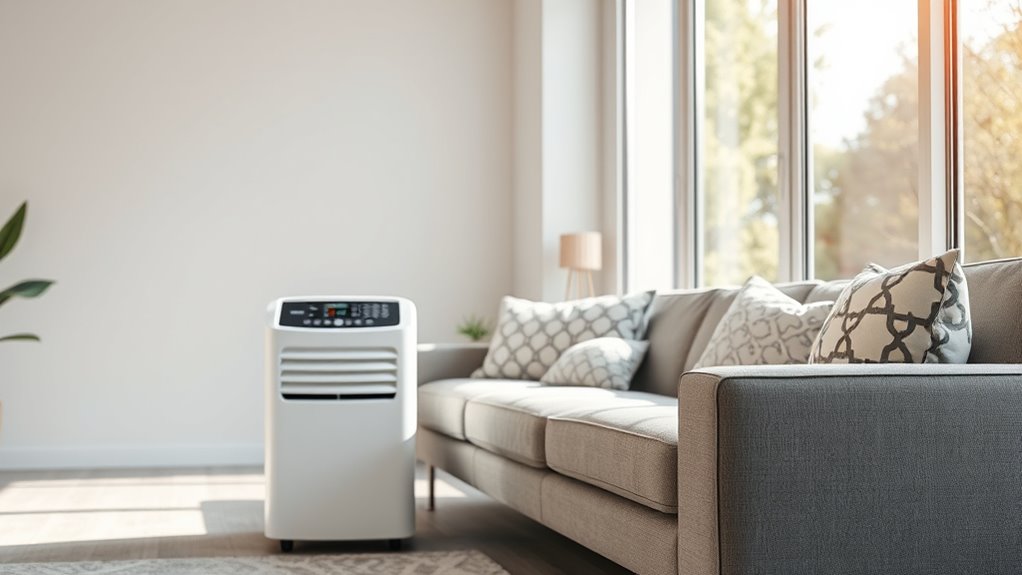
Choosing the right BTU rating for your space starts with understanding its size and layout. An appropriately sized AC ensures efficient cooling and minimizes energy consumption, leading to better energy savings. If your room is too small for a high BTU unit, it’ll cycle on and off frequently, wasting energy. Conversely, an oversized unit may cool too quickly, causing unnecessary energy use and humidity issues. To optimize your setup, follow installation tips like sealing leaks and insulating windows, which help the unit work more efficiently. Consider factors like ceiling height, sunlight exposure, and the number of occupants to select the correct BTU. Proper shower maintenance also plays a role in overall bathroom efficiency, indirectly supporting your cooling system’s performance. Taking these steps guarantees comfort while maximizing energy savings, making your cooling system both effective and economical.
Tips for Making the Best AC Purchase Decision

Making the best AC purchase decision requires careful consideration of your specific needs and budget. Start by evaluating your space size and climate to choose an efficient model that offers good energy savings. Look for units with high SEER or SACC ratings, as these can lower your energy bills over time. Don’t forget to take into account installation considerations—professional setup ensures optimal performance and reduces future issues. Proper placement and ventilation can maximize cooling efficiency and lifespan. Keep in mind that a slightly higher upfront cost for a more efficient unit can lead to significant savings later. Comparing energy efficiency ratings and features can help you identify the most cost-effective option for your home. Compare features, warranties, and energy labels to find the best balance between cost and performance. Making an informed choice now will lead to a cooler, more energy-efficient home in the long run.
Frequently Asked Questions
Can SACC Ratings Vary Between Different AC Brands?
Yes, SACC ratings can vary between different AC brands. You might notice differences due to brand variations in manufacturing and technology, which affect rating consistency. Some brands may have more precise or higher-quality components, leading to more reliable SACC ratings. It’s essential to compare brand reputations and reviews to guarantee you’re getting an air conditioner with a consistent and accurate SACC rating for ideal performance.
How Do Climate Conditions Influence the Importance of SACC and BTU?
Imagine your AC as a chameleon, adapting to climate changes. Climate conditions greatly impact the rating’s importance; in humid areas, a higher SACC helps control moisture, while BTU affects cooling power in hot climates. You’ll find climate adaptation vital when selecting an AC, as the rating significance shifts with weather. For example, in tropical regions, focusing on SACC ensures comfort, making both ratings essential for ideal performance.
Are There Specific Room Types Better Suited for SACC or BTU Ratings?
You’ll find that larger rooms with poor insulation benefit more from higher BTU ratings, ensuring enough cooling power. Smaller, well-insulated rooms are better suited for units with higher SACC ratings, which focus on efficiency. Consider room size and insulation quality when choosing between SACC and BTU ratings. Properly matching these factors helps you select an AC that cools effectively without wasting energy or overworking the unit.
Do Energy Efficiency Labels Incorporate SACC or BTU Measurements?
Did you know that over 80% of energy labels include BTU ratings? These rating systems help you compare appliance efficiency easily. Energy labels primarily focus on BTU measurements to show cooling capacity and efficiency, making it easier for you to choose an efficient unit. SACC ratings are less commonly incorporated into these labels, so looking at BTU and overall energy efficiency ratings gives you the most reliable information.
How Does Maintenance Affect the Performance Indicated by SACC and BTU?
Maintenance impact is significant on both SACC and BTU ratings, directly affecting your AC’s performance. When you neglect regular upkeep, you experience performance degradation, meaning your unit cools less effectively. Dirty filters, clogged coils, and low refrigerant levels reduce efficiency, making it seem like your AC isn’t working as hard as it should. Proper maintenance restores ideal performance, ensuring your system runs efficiently and cooling capacity remains consistent.
Conclusion
Now that you know the difference, don’t get stuck choosing based solely on BTU. SACC actually tells you how well an AC cools efficiently, saving you money and energy in the long run. I get it—BTU seems familiar, but trust me, focusing on SACC makes your decision smarter. So, next time you’re shopping, prioritize that rating — your wallet and the environment will thank you!
